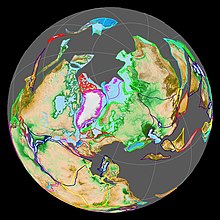
Back Laurasië Afrikaans لوراسيا Arabic Laurasia AST Lavrasiya Azerbaijani Лаўразія Byelorussian Лавразия Bulgarian লরেশিয়া Bengali/Bangla Laurazia Breton Laurazija BS Lauràsia Catalan
 Laurasia (centre) and Gondwana (bottom) as part of Pangaea 200 Mya (Early Jurassic) | |
| Historical continent | |
|---|---|
| Formed | 1,071 Mya (Proto-Laurasia) 253 Mya |
| Type | Supercontinent |
| Today part of |
|
| Smaller continents | |
| Tectonic plates | |
Laurasia (/lɔːˈreɪʒə, -ʃiə/)[1] was the more northern of two large landmasses that formed part of the Pangaea supercontinent from around 335 to 175 million years ago (Mya), the other being Gondwana. It separated from Gondwana 215 to 175 Mya (beginning in the late Triassic period) during the breakup of Pangaea, drifting farther north after the split and finally broke apart with the opening of the North Atlantic Ocean c. 56 Mya. The name is a portmanteau of Laurentia and Asia.[2]
Laurentia, Avalonia, Baltica, and a series of smaller terranes, collided in the Caledonian orogeny c. 400 Ma to form Laurussia/Euramerica. Laurussia/Euramerica then collided with Gondwana to form Pangaea. Kazakhstania and Siberia were then added to Pangaea 290–300 Ma to form Laurasia. Laurasia finally became an independent continental mass when Pangaea broke up into Gondwana and Laurasia.[3]
- ^ Oxford English Dictionary
- ^ Du Toit 1937, p. 40
- ^ Torsvik & Cocks 2004, Laurussia and Laurasia, pp. 558, 560
© MMXXIII Rich X Search. We shall prevail. All rights reserved. Rich X Search